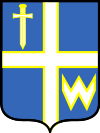 Alternate names: Wielopole Skrzyńskie [Pol], Vielipoli, וילופולה [Yid], Wielopole. 49°57' N, 21°37' E, 18 miles WSW of Rzeszów, 7 miles S of Ropczyce. Jewish population: 465 (in 1890). Słownik Geograficzny Królestwa Polskiego (1880-1902), XIII, pp. 361-362: "Wielopole" #4. This village in Podkarpackie province in the Ropczycko Sędziszowski powiat and seat of the Wielopole Skrzyńskie gmina. From 1975-1998, the village was in Rzeszów woj.[July 2009]
Alternate names: Wielopole Skrzyńskie [Pol], Vielipoli, וילופולה [Yid], Wielopole. 49°57' N, 21°37' E, 18 miles WSW of Rzeszów, 7 miles S of Ropczyce. Jewish population: 465 (in 1890). Słownik Geograficzny Królestwa Polskiego (1880-1902), XIII, pp. 361-362: "Wielopole" #4. This village in Podkarpackie province in the Ropczycko Sędziszowski powiat and seat of the Wielopole Skrzyńskie gmina. From 1975-1998, the village was in Rzeszów woj.[July 2009]
Normal 0 CEMETERY: Located SE of the village near the buildings of the Gminnej Cooperative " Samopomoc Chłopska, older residents remember many polychrome-decorated matzevot. The cemetery was destroyed during WWII. Without gravestones, the long abandoned cemetery served as a pasture. MASS GRAVE: During the Holocaust, the Nazis shot Jews here, but the largest execution came during the liquidation of the ghetto on June 30, 1942, when a German SS unit murdered 42 mostly elderly and sick people. They were made to kneel on the edge of the 10-meter grave. They were shot in the back of the head and tumbled to the bottom. No one escaped. All knew their fate. In the 1990s, a fragment of a metal fence adorned with Mogen David was found. In the center, a symbolic tomb was built and inscribed in Hebrew, English, and Polish for Judah Redel. On the left side of the monument is a metal plaque with the names of Jews murdered here on. June 30, 1942. In addition, two recovered gravestones were reset. Photos. [July 2009]
US Commission No. POCE000783
The town is located in Rzeszow st. region at 21º37 49º57, 35 km. from Krosno. Cemetery: behind bakery. Present town population is 1,000-5,000 with no Jews.
- Local: Urzad Giminy, 39-110 Wielopole Skrzynskie, tel. 819.
- Regional: Wojewodzki Konserwator Zabytkow, Rzesnow, ul. Michiewicla 7, tel. 394-61.
The earliest known Jewish community dates from the 16th century. The 1939 Jewish population was 935. The synagogue, about 500 meters from the cemetery, was destroyed during WWII. Rabbi Izaak Lipcitz lived in this town. The landmarked cemetery was established in the 17th century with last Orthodox burial in the cemetery 1942-45. The isolated rural/agricultural hillside has no sign but has Jewish symbols on gate or wall. Reached by turning directly off a public road and crossing private property, access is open to all with a continuous fence and no gate. The pre-WWII size was 1,000 sq. m.; and the post-WWII cemetery size is 50 sq. meters. The reduced size of the cemetery is due to agriculture . No stones are visible. Two stones are in the private collection of the Urzad Gminy at Wielopole Skrzynskie. One stone may be in the cemetery. The 20th century sandstone rough stones/boulders tombstones are inscribed in Hebrew. There are known marked mass graves. The municipality owns property used only as a Jewish cemetery. Adjacent property is agricultural and residential. Rarely, private visitors and organized Jewish groups stop. It was vandalized during World War II but not in the last ten years. Maintenance: fixing wall by local/municipal authorities in 1991. No care or maintenance. Within the limits of the cemetery are no structures. Security is a very serious threat. Vandalism is a slight threat.
Natascha Rode, 35 Rzesnow, ul. Starzynskiego 5/29 completed survey in June 1992 using interviews at the site: Julian Smietana of 39-110 Wielopole Skrzynskie 74, tel. 67.
